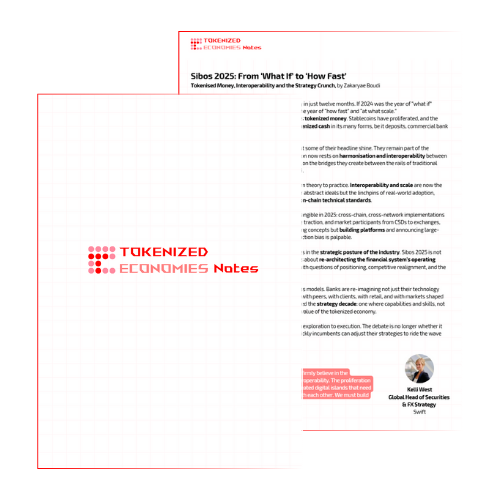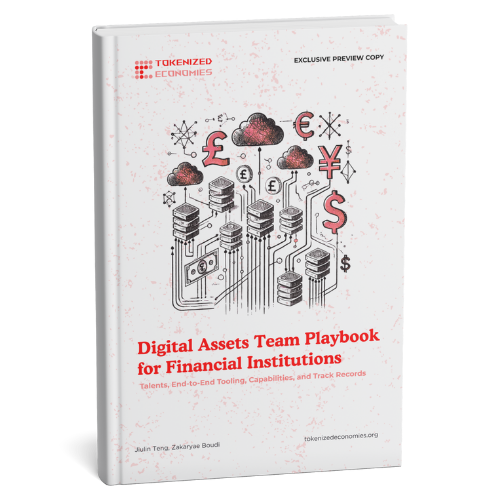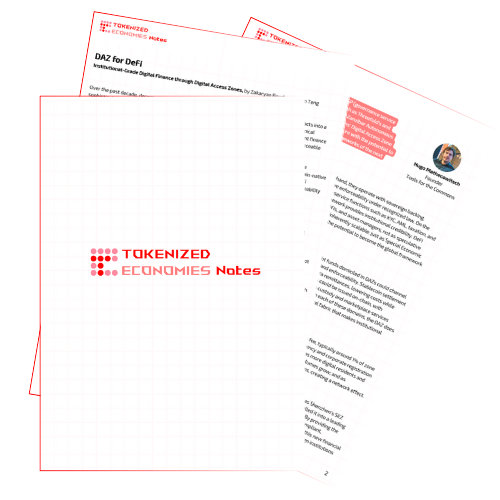Tokenized Economies: A New Paradigm

Tokenized Economies: Unlocking a New Paradigm for Global Finance
Tokenization is no longer a fringe experiment—it is fast becoming a foundational layer of the next financial era. In our latest publication, “Tokenized Economies: A New Paradigm”, the Tokenized Economies Institute outlines the case for a radical transformation in how assets are created, exchanged, and managed.
From money and debt to identity and infrastructure, the report charts a roadmap for transitioning from isolated blockchain pilots to a cohesive, interoperable digital asset economy.
The Token Transformation: Assets, Reimagined
At its core, tokenization converts rights to assets—tangible or intangible—into programmable digital tokens on blockchain networks. Whether real estate, debt, intellectual property, or carbon credits, tokenization enables fractional ownership, enhanced liquidity, and full lifecycle automation.
What makes tokens transformative is their capacity to embed rules, permissions, and conditions directly into the asset itself. From issuance and trading to interest payments and redemption, every step is handled through smart contracts. The result: less friction, more transparency, and radically improved efficiency.
A tokenized debt instrument, for example, can be bought, sold, collateralized, and redeemed—all on-chain, with compliance checks, interest flows, and repayment schedules managed autonomously. This is not an upgrade—it is a redefinition of how financial instruments function.
The Catalysts of Change: Four Key Trends
The report identifies four core trends shaping the future of tokenized economies:
- Tokenization of Money: Stablecoins, tokenized deposits, and CBDCs are anchoring the digital currency frontier. These instruments blend blockchain efficiency with fiat stability—paving the way for faster, more inclusive financial rails.
- Tokenized Financial Instruments and Real-World Assets (RWAs): Bonds, equities, derivatives, and carbon credits are being brought on-chain with built-in lifecycle logic and compliance layers. Tokenization enhances their tradability and enables novel financial structuring.
- On-chain Capital Market Infrastructure: Exchanges, custody, and regulatory systems are being re-architected for tokenized assets. These platforms deliver real-time settlement, transparent audit trails, and seamless compliance—bringing trust and speed to previously fragmented markets.
- Digital Identity: Tokenized identities will be pivotal in KYC, AML, and access control. A secure, portable, and programmable digital identity layer is essential for financial services, government, and healthcare in an increasingly digitized world.
Overcoming the Barriers
As promising as tokenization is, its success hinges on tackling several critical barriers:
- Regulatory Clarity: Fragmented legal frameworks remain one of the most urgent hurdles. The report calls for global coordination and innovation-friendly guidelines that enable adoption without compromising oversight.
- Interoperability: Siloed chains and proprietary standards limit network effects. Tokenized economies need seamless cross-chain operability and integration with traditional financial infrastructure.
- Security and Compliance: From cyber threats to AML protocols, trust requires rigor. Robust encryption, smart contract audits, and embedded compliance layers are non-negotiable for institutional participation.
- Infrastructure Development: Scalable networks, intuitive user interfaces, tokenization platforms, and secure custody are the scaffolding of a functioning tokenized economy. These must evolve in parallel with regulation and market maturity.
Infrastructure Is Emerging
Tokenized economies are not a future possibility—they are an unfolding reality. As this report makes clear, the shift toward programmable, modular, and transparent asset systems is already underway. The challenge now is to scale them thoughtfully, inclusively, and securely.
By embracing open standards, overcoming regulatory friction, and building usable infrastructure, we can reshape the global economy from the ground up—more connected, more efficient, and more accessible than ever before.





